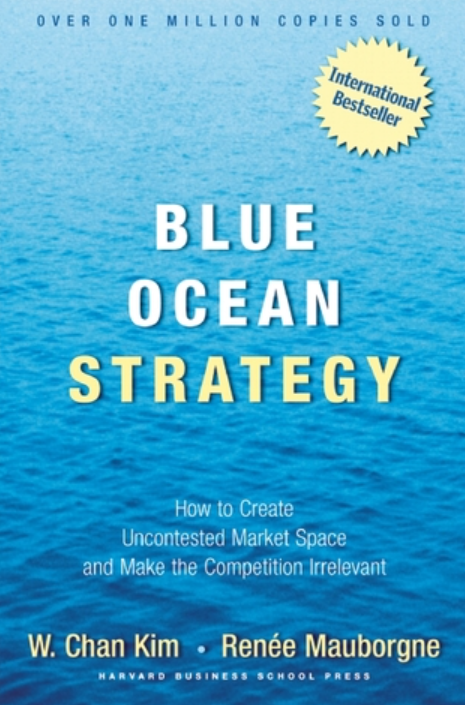Offering a radical and practical new approach to strategy, the Blue Ocean Strategy is a book by Chan Kim and Renee Mauborgne. The idea is that competition should be seen as a red ocean because it’s all about fighting bloody competition to survive in the same shrinking space. To stand out from other competitors, an organization should do the opposite and create uncontested markets-blue oceans-by breaking away from enduring industry standards and creating new demand.
This global bestseller contains a detailed approach on selecting niches with little to no competition and developing a sound marketing strategy.
This post is a summary of Blue Ocean Strategy: How to Create Uncontested Market Space and Make the Competition Irrelevant, highlighting the best concepts and ideas we have got from reading it and we are also going to tell you whether it is worth reading the complete book.
Blue Ocean Strategy Summary
Avid readers in the business and entrepreneurship spaces will be familiar with the concepts of “Blue” and “Red” oceans. A blue ocean depicts a calm and beautiful day, while a red ocean elicits feelings of competition, aggression, and competitiveness. This is exactly what is meant by a Blue Ocean strategy.

A business that selects to begin its journey in a niche that is not saturated will improve its chances of success. This is to be taken with a grain of salt, however, since the presence of some competition signals that there is enough market demand for the service or product provided.
The natural next question is, how would I be able to identify a niche which is not saturated and where businesses do not fight each other the smallest pieces of market share. If this question had an obvious answer, there would be no blue ocean strategies available today.
Luckily, Kim and Mauborgne use both practical and data-driven examples to clearly explain how to identify, or even create, your blue ocean niche.
Creating a Blue Ocean
Kim and Mauborgne begin this book by explaining that the only way to identify a blue ocean strategy is to learn how one is created. It is no secret that without much competition, yet still a desire to purchase your created solution, the business has an almost guaranteed chance of a successful launch. When first thinking about a niche, you may tend to think very generally, yet the best way to identify and create a blue ocean strategy is to narrow down and specify the niche.
Kim and Mauborgne posit that there are three different ways this can be achieved:
- By redefining an existing problem. This is more about creative thinking and positioning than it is bringing something new to the market. This method is the toughest in terms of mindset but maybe the easiest to execute once it’s found out. An example is a lobster. up until the early 1900s, lobster was seen as a very undesirable creature. It was either thrown away, used as fertilizer, or sold to the poor. It was also extremely abundant in the eastern North American provinces and states. Once marketed properly to tourists, lobster became what it is today, prized gourmet food at restaurants.
- Innovate disruptively. The opposite of redefining an existing problem is to completely create something new. In contrast to the above, this is easier to position to others but extremely hard to invent something unique. Once someone makes a technological breakthrough, a blue ocean strategy then becomes natural. This is the common thought behind a blue ocean strategy, and of course, no one can innovate every single day. The most relatable example is movie streaming services that put video rental companies out of business.
- Non-disruptive creation. The middle ground between the two strategies above takes elements from both points above and creates a product that solves a problem that was previously not thought of or unsolved. Examples usually include luxury or taboo subjects such as addiction and sex. Nicotine patches, for example, did not disrupt any industry or redefine a problem. Once the population shifted towards being more self-conscious, smoking cessation became a new blue ocean niche.
Identifying Pain Points
A business, at its core, is an organization that was created to solve a problem. If your problem is too small, or you fail to identify and explain your solution, the business will not be successful.
For this reason, identifying a blue ocean strategy, or even a business at all comes firstly by seeking out issues, problems, and pains that your potential customers are having. to further explore a current niche, narrowing down your search will help to further identify problems that may not even be addressed with the current structure.
Blue Ocean Strategy goes further on to explain the 6 different types of buyer experience stages and the six different types of utility levers. The exercise that is encouraged in the book is to create a table that intersects these two themes and to walk yourself through the customer life-cycle of purchase and eventual disposal. Expanding on what was said above regarding narrowing down a niche here is an example:
clothing is a broad niche that is oversaturated. athleticwear may be less saturated but still very competitive. Athleticwear for women is better, however, many companies still focus on this. Athleticwear for women that are 6-18 months postpartum and are trying to reclaim a somewhat active schedule in their lives, maybe a winner.
Beyond The Assumption
The death of many larger organizations has come from assuming that the way things are will always be. Companies use past data and assumed habits and practices to further model and plan out their future, unaware of shifting trends and preferences that can completely impact business. the book breaks this down into 4 different points:
- Can new products and offerings be created?
- What parts of the business are not, or least, profitable? can they be terminated?
- Are there products that are below par and can be improved?
- From our current elite products and services, is there a more affordable entry option?
In the Blue Ocean Strategy, this is called the four action framework and is an ongoing homework that is positioned forever, business owner.
For example, companies that make only luxury products and compete against each other could look into developing affordable products for a large audience, and market them accordingly.
In contrast, high-turnover businesses that focus on being cost-leaders can solidify their place in the market against new entrants by creating a line of more prestigious services that set them apart in value, and not just price.
Blue Ocean Strategy Review – Should You Read it?
As it is with more academic and specific books, this book needs to be read cover to cover, and even referenced, for the entire message to be consumed. exact lessons such as the buyer experience stages and utility levers are a matrix that can only be properly explained by the authors via their book. Blue Ocean Strategy can be recommended to everyone that owns a business because, at the heart of the data and instructions, this is a stellar book about branding and marketing.
Summary
With an array of call-to-actions and clear advice, this book can be one of the only few that you need to launch and keep a successful business.
Not only does it assist in identifying a niche that has low competition, but it also ensures that you can uncover the needs, wants, and pains of customers that may not have previously been addressed. Swim in more peaceful waters using the Blue Ocean Strategy.

